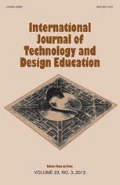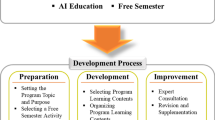Abstract
In Ireland, Technology Education’s structure and organisation across the levels of education is not delivered or governed in a coherent manner. Technology Education in primary level education, for students between 5 and 12 years of age, does not explicitly exist as a separate subject. In primary level education, Social, Environmental and Scientific Education (Science), encourages a child to examine and appreciate how technology and science impacts on their lives and the environment. It supports children developing design and make skills, and to apply scientific ideas to everyday situations and practical problems (DES in Primary school curriculum, science. Social, environmental and scientific education curriculum, 1999). In addition, various initiatives such as the Junior Lego League, supported by the Galway Education Centre, facilitate various perspectives of Technology Education. In second level education, which this paper primarily focuses on, Technology Education exists as a suite of eight subjects, for students of 12–18 years of age. In third level education students can choose from a wide range of bachelor degree programmes in science, technology, engineering or maths. The degree programmes available at third level also include programmes in initial teacher education (ITE). These programmes in initial teacher education are offered by two institutions, and graduate second level teachers to service the second level system. Technology Education in second level education was first introduced to Ireland in 1885. Since this introduction, revisions and changes have occurred, in both the Irish economy and syllabi. In 2006, Technology Education syllabi were revised to include more design activity at senior cycle. These changes reflect the forward thinking of policy makers in reflection of the progression from the industrial era to the information era to the conceptual era. The scope of second level Technology Education in an Irish context is still perceived by many as vocational, though progressive reformations are advancing towards a design-driven framework, grounded in a strong craft practice. This changing technological environment has resulted in the promotion of design activity in second level Technology Education in Ireland. This paper reviews the establishment of design education in Technology Education in the Irish second level education context, where an epistemological shift towards design activity has occurred.

Similar content being viewed by others
Notes
From 2012, 25 Additional points are available to students taking higher level Mathematics.
References
Alamäki, A. (2000). Current trends in technology education in Finland. The Journal of Technology Studies, XXVI (1), Winter/Spring 2000, 19–23.
Barlex, D. M., & Trebell, D. (2008). Design-without-make: Challenging the conventional approach to teaching and learning in a design and technology classroom. International Journal of Technology and Design Education, 18, 119–138.
Berglund, A. and Leifer, L. (2013) Why we prototype! An international comparison of the linkage between embedded knowledge and objective learning. Engineering Education, 8 (1), J. Davies, The Higher Education Academy (July 2013)
Black, P. (1998). An international overview of curricular approaches and models in technology education. Journal of Technology Studies. XXIV(1), 24–30.
Carty, A., & Phelan, P. (2006). The nature and provision of technology education in Ireland. Journal of Technology Education, 18(1), 7–26.
Darmody, M. and Smyth, E., (2013) Governance and funding of voluntary secondary schools in Ireland. Research Series Number 32. October 2013. Publisher: ESRI.
DES (1999) Primary school curriculum, science. social, environmental and scientific education curriculum. Government of Ireland, Department of Education and Science. Stationary office, Dublin.
DES (2004a) The senior cycle in second-level schools, Department of Education and Science. Accessed at: http://www.education.ie/en/Publications/Education-Reports/The-Senior-Cycle-in-Second-Level-Schools.pdf.
DES (2004b) A brief description for the Irish Education System. Publisher Communications Unit Department of Education and Science.
Friedman, K. (2000). Creating design knowledge: From research into practice. International Conference on Design and Technology Educational Research and Curriculum Development. Loughborough University Department of Design and Technology.
Hammond and Palmer. (1999). Engineering education at second level in the Republic of Ireland: Provision and developments. International Journal of Engineering Education, 15(2), 82–93.
HEA (2012) Full - time undergraduate enrolments in All HEA-Funded Institutions by field of study (ISCED)1 at 1 March 2012. Higher Education Authority. Accessed at http://www.hea.ie/en/statistics/overview.
HEA and NCCA (2013) Supporting a better transition from second level to Higher Education. Key directions and next steps. Foreword by the Minister for Education and Skills, Ruairi Quinn). Stakeholders: Higher Education Authority, National Council for Curriculum and Assessment, Department of Education and Skills (DES), the Higher Education Authority (HEA), the Irish Universities Association (IUA), Institutes of Technology Ireland (IoTI) and the State Examinations Commission (SEC).
Hennessy, L. (2000). The future of technological educations in developing 21st century. Engineering Technology Teachers Association, 1, 48–57.
Innovation Taskforce (2010) Innovation Ireland. Report of the Innovation Taskforce. March 2010. Ireland—The Smart Economy. Department of the Taoiseach, Government Buildings, Upper Merrion Street, Dublin 2. Publisher: The Stationary Office, Dublin.
Kimbell, R., & Perry, D. (2001). Design and technology in a knowledge society. Design and technology a distinctive model of teaching and learning. London: Engineering Council.
Leahy, K. (2009). A strategic approach to education and training in design activities in the Technologies in Ireland. Limerick: Doctor of Philosophy, University of Limerick.
Martin, M. & Owen-Jackson, G. (2013) Is design and technology about making or knowing? In G. Owen-Jackson (Ed.) Debates in design and technology education (pp. 64–73).
McCormick, R. (1991). The evolution of current practice in technology education. Integrating Advanced Technology into Technology Education, NATO ASI Series, 78(1991), 41–55.
NCCA (1991) Materials technology wood syllabus. Ordinary level and Higher level. National Council for Curriculum and Assessment.
NCCA (2006) Leaving certificate technology syllabus. Ordinary level and Higher level. National Council for Curriculum and Assessment.
NCCA (2007) Leaving certification design and communication graphics syllabus. For implementation in Sept 2007. National Council for Curriculum and Assessment.
OECD and Gallagher, N. (2003). Education at a glance. Teacher Education, Organisation for Economic Cooperation and Development.
O’ Sullivan, G. (2013) Design and technology education: Vocational or academic? A case of yin and yang. In G. Owen-Jackson (Ed.) Debates in design and technology education (pp. 74–85).
Owen-Jackson, G. (2013). Debates in design and technology education. G. Owen-Jackson (Ed.), Routledge.
Peppers, D. (2009) Dancing shoes for honeybees. Customer networks and empowered brand advocates. Peppers and Rogers Group. Accessed at http://www.slideshare.net/michaelbuckley/don-peppers on 01/06/2013.
SEC (2009a) Chief Examiners Report Construction Studies. State Examinations Commission
SEC (2009b) Chief Examiners Report Design and Communication Graphics. State Examinations Commission
SEC (2009c) Chief Examiners Report Technology. State Examinations Commission
SEC (2011) Chief Examiners Report Engineering. State Examinations Commission
Williams, P. J. (2000). Design: The only methodology of technology? Journal of Technology Education, 11(2), 48–60.
Wolf, A. (2011) Review of vocational education—The wolf report. Department for Education and Department for Business, Innovation & Skills. Published 3 March 2011. Policy: Improving the quality of further education and skills training.
Author information
Authors and Affiliations
Corresponding author
Rights and permissions
About this article
Cite this article
Leahy, K., Phelan, P. A review of Technology Education in Ireland; a changing technological environment promoting design activity. Int J Technol Des Educ 24, 375–389 (2014). https://doi.org/10.1007/s10798-014-9266-z
Accepted:
Published:
Issue Date:
DOI: https://doi.org/10.1007/s10798-014-9266-z





